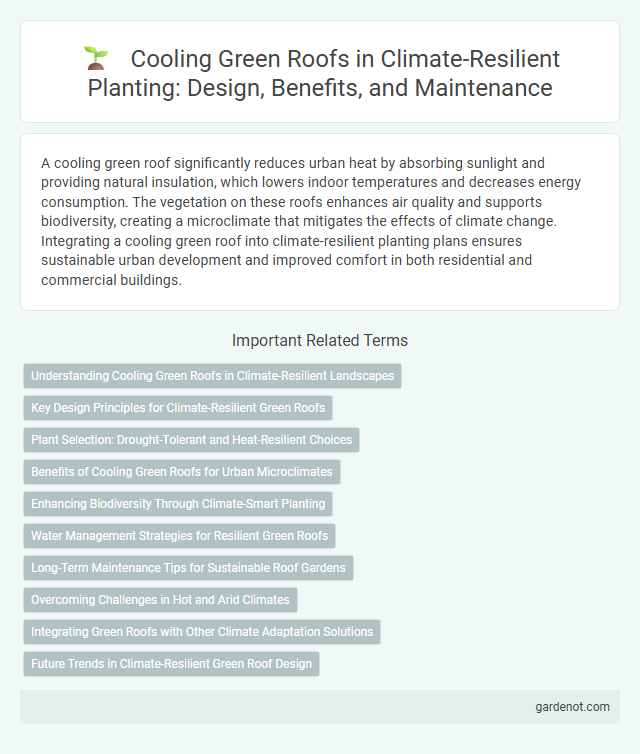A cooling green roof significantly reduces urban heat by absorbing sunlight and providing natural insulation, which lowers indoor temperatures and decreases energy consumption. The vegetation on these roofs enhances air quality and supports biodiversity, creating a microclimate that mitigates the effects of climate change. Integrating a cooling green roof into climate-resilient planting plans ensures sustainable urban development and improved comfort in both residential and commercial buildings.
Understanding Cooling Green Roofs in Climate-Resilient Landscapes
Cooling green roofs enhance urban climate resilience by reducing ambient temperatures through evapotranspiration and shading, which lowers heat absorption on building surfaces. Incorporating diverse, drought-tolerant vegetation improves thermal regulation while minimizing water usage, crucial in climate-stressed regions. Integrating green roofs into city planning mitigates urban heat island effects and promotes sustainable stormwater management.
Key Design Principles for Climate-Resilient Green Roofs
Cooling green roofs enhance urban climate resilience by reducing heat island effects and improving energy efficiency. Key design principles include selecting drought-tolerant, native plant species with high albedo, optimizing substrate depth for water retention, and ensuring proper drainage to prevent waterlogging. Incorporating diverse vegetation layers and strategic shading elements maximizes cooling benefits and supports biodiversity.
Plant Selection: Drought-Tolerant and Heat-Resilient Choices
Selecting drought-tolerant and heat-resilient plants for cooling green roofs enhances thermal regulation while minimizing water usage. Species such as sedum, lavender, and native grasses thrive under extreme heat and limited moisture, providing effective insulation and reducing urban heat islands. Incorporating these resilient plants contributes to sustainable, climate-adaptive urban ecosystems with improved energy efficiency and biodiversity.
Benefits of Cooling Green Roofs for Urban Microclimates
Cooling green roofs significantly reduce urban heat island effects by lowering rooftop temperatures through evapotranspiration and shading, which enhances thermal comfort in densely built areas. These vegetated roofs improve air quality by filtering pollutants and increasing oxygen levels, contributing to healthier urban microclimates. Energy savings are achieved as buildings require less cooling, reducing greenhouse gas emissions and promoting climate resilience in cities.
Enhancing Biodiversity Through Climate-Smart Planting
Cooling green roofs use climate-resilient planting techniques that promote biodiversity by selecting native, drought-tolerant species adapted to urban microclimates. These plants support local pollinators, reduce heat islands, and improve stormwater retention, creating a thriving ecosystem on rooftop surfaces. Integrating diverse plant species enhances ecological connectivity and contributes to climate mitigation and urban resilience.
Water Management Strategies for Resilient Green Roofs
Cooling green roofs enhance urban climate resilience by integrating advanced water management strategies, including rainwater harvesting and efficient irrigation systems that optimize moisture retention. Strategic use of permeable layers and vegetation selection reduces runoff and maximizes evapotranspiration, thereby lowering rooftop temperatures and mitigating heat island effects. Incorporating substrates with high water-holding capacity supports plant health during drought conditions, ensuring sustained cooling performance and structural durability.
Long-Term Maintenance Tips for Sustainable Roof Gardens
Regular irrigation and soil moisture monitoring are essential for maintaining a cooling green roof's effectiveness in mitigating urban heat. Selecting drought-tolerant, native plant species reduces water demand and enhances resilience against extreme weather events. Periodic inspection of drainage systems and timely removal of debris prevent waterlogging and structural damage, ensuring long-term sustainability of roof gardens.
Overcoming Challenges in Hot and Arid Climates
Cooling green roofs in hot and arid climates require drought-tolerant plant species such as succulents and native grasses, which minimize water consumption while maximizing evapotranspiration. Advanced substrate materials with high water retention and reflective properties help reduce roof surface temperatures and improve thermal insulation. Implementing efficient irrigation systems like drip irrigation and rainwater harvesting addresses water scarcity challenges, ensuring sustainable maintenance of the green roof ecosystem.
Integrating Green Roofs with Other Climate Adaptation Solutions
Integrating cooling green roofs with rainwater harvesting systems enhances urban climate resilience by reducing heat islands and managing stormwater efficiently. Combining green roofs with reflective roofing materials and permeable pavements improves temperature regulation and minimizes surface runoff. Utilizing native, drought-tolerant plants on green roofs supports biodiversity while lowering maintenance costs in climate adaptation strategies.
Future Trends in Climate-Resilient Green Roof Design
Future trends in climate-resilient green roof design emphasize adaptive plant selection and advanced substrate technology to enhance cooling efficiency and drought tolerance. Integration of smart irrigation systems and reflective materials boosts thermal regulation and water conservation on urban rooftops. Innovations in modular green roof systems allow scalable deployment, improving urban microclimates and reducing heat island effects.
Cooling green roof Infographic

 gardenot.com
gardenot.com